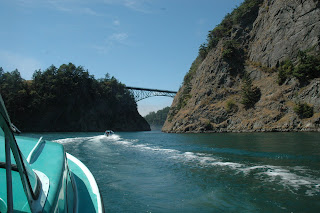We are joining other club members tomorrow for a circumnavigation of Fidalgo Island, starting and ending in La Conner. But the tides tomorrow morning are very low, so I got up early today and put in at the La Conner ramp, then motored over to Shelter Bay where I have moorage for the night.
I was by myself this morning – launched around 6 a.m. – and things went very smoothly. The tide was a little over 2' with virtually no current. I tied up both bow and stern lines with lots of slack and just unhitched the boat: the steepness of the ramp at that tide level meant the Welike slid off on her own with very little encouragement.

Notice our new Town of La Conner ramp dock; wider and more stable – really pretty snazzy. There is room for boats to tie up comfortably on both sides of the float.After parking the truck and paying my ramp fee I started up the engine, cleaned off the foggy windshield and adjusted side curtains, then motored slowly up the channel to the north basin, where we'll rendezvous tomorrow with the rest of the club boats. Several of them are launching on the slings up there. Then, I motored back to Shelter Bay, where we are in C-41 for the night.

While waiting for the office to open at 8 am I installed the cigarette lighter style power points; I got a dual outlet so I can have the hand-held VHF radio and the iPhone plugged in at the same time.
As I motored back I experimented with the GPS chart plotter and finally figured out how to make the screen display track with the boat. I have heading, speed over land, depth and of course chart position on the same display now. So, Amanda, next time you drive it will be a LOT easier to figure out where you are!
After paying moorage I walked home; took about 20 minutes to go up and over the hill.
We are off to Seattle today to visit my old friend Chris Mitchell in Winslow, then we'll be heading home for the night. Tomorrow we will probably drive over to the boat around 9 am to get fuel and meet up with the gang around 10.
SATURDAYFran and I rushed over to Shelter Bay this morning, a little late. We were supposed to meet up with the other boaters at 10. Shouldn't have worried: the sling hoist at the Port of Skagit marina was on the fritz. By the time we motored up there and got our gas tanks topped off, the line of classic boats was just starting to enter the water. A couple of Skagit 17s. Another 20. A Bell Boy 18, a 21 foot Dorsett Farallon, and a couple other boats. Nearly all of them are beautifully restored, and their owners are some of the nicest people we've met in years.

We all headed out around 11:30, having teamed up into groups of 2 or 3 "buddy" boats. Our buddies were Clint Stroebel in his Skagit 17, and Bruce Bridwell, in a Skagit 20 -- the WillaB -- like ours. Only his has been in his family since the day his dad bought it in 1958, and it is totally original.
Unfortunately, the WillaB started having engine trouble with its 35 year old Johnson, so about 2/3 of the way up the channel the three of us had to turn back to port. Bruce worked on the engine en route, though, and by the time we were back to La Conner it was running fine. Instead of re-tracing our steps we decided to keep heading south and make for Deception Pass, then meet up with the other boats in Bowman Bay after their trip around the north side of the island.
The passage was fairly uneventful until we got to Deception Pass. There, a huge fog bank obscured most of the bridge and much of the surface ahead of us. Luckly though it started to clear a bit, and Clint led us through the smaller of the two passages. Fran drove while I took pictures of the sheer rock walls and beautiful boiling water as the fog slowly lifted and bathed the scene in misty golden light.
A shot of the WillaB, exiting Canoe Pass.
We continued over to Bowman Bay, where the club took over the big float. We sat in the sun, visited, ate picnic lunches, looked over each other's boats and generally had a very convivial time.


Around 4:30 we headed back through the pass - this time taking the main channel. We circled around Hope Island and Clint pointed out the nice little beach camping site on the northwest side of the island. Then we hurried on back to La Conner, where Fran and I took the boat out of the water at the town ramp. All around great day!












